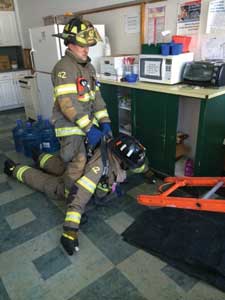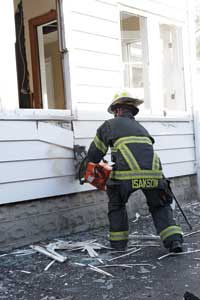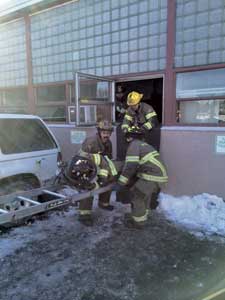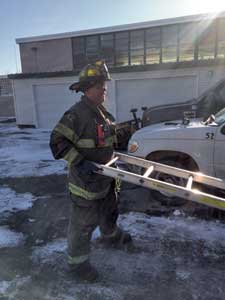<Previous Displaying 2/2 Page 1, 2
View Article as Single page
Victim Positioning
Prior to beginning the operation, remember some basic firefighting procedures. If you remove a window for victim removal, you’ve also created an avenue of ventilation for the byproducts of the fire. One of your first actions should be to close the door to the room you’re operating in. This protects you from flames, smoke, and gases and may also increase visibility. Next, make the window into a door by removing the glass, sash, curtains, and blinds. Working from the inside and punching outward reduces the glass inside on the floor where you’re working; if you’re venting from outside, try and pull outward. Remember to always wear appropriate safety equipment when performing this tactic.
Depending on the victim’s size and the smoke conditions, it may be difficult to place a victim onto the ladder. The firefighters operating inside the structure have a few choices: They can put him face down, on his back, or on his side. If you haven’t placed the ladder in the window, you could lift up the victim, slide the ladder under him, and drag him up the ladder like it was a ramp (photo 7). If the victim is perpendicular to the ladder, you can drag him over the end of the ladder so his midpoint is balanced on the ladder. Then firefighters outside can pull down on the ladder, lifting the victim off the floor. Next the two firefighters inside can spin the victim easily on the ladder so his body is horizontal to it and remove him from the building. This method works well in training with large victims.
 |
|
(7) One firefighter pulls up another firefighter while sliding the ladder under him; then he can slide or pull up the victim and roll him onto the ladder for removal. (Photos 7-12 by Megan Ciampo.) Click to view video |
When removing a down firefighter, laying him on his side is probably the best position. If you place him on his back, the SCBA tank doesn’t sit properly on the ladder, and the firefighter moves when you pull him out the window. Plus, the firefighter’s helmet drops into the rung spacing, which could get snagged on the windowsill, causing an injury. If you place him face down, the SCBA face piece has a tendency to fall through the rung spacing, and the firefighter’s neck could get jammed on the windowsill during removal. On his side, his neck could still drop; thus, during the removal, one firefighter should be at his head to guide it during the removal and prevent it from being caught between the sill and the ladder. In training, I’ve also noticed that when using the side position, there is a tendency to snag stuffed bunker gear pants pockets. If the pockets fall in between the rungs at the sill, they can catch while sliding outward. A simple solution is to slide the ladder back in a few inches or a foot, lift the ladder (releasing the snag), and continue with the removal.
Firefighter Ladder Positions
Once the two firefighters place the victim onto the ladder, one positions at the butt of the ladder while the other goes toward the victim’s head and the windowsill (photo 8). This firefighter gives the verbal commands to pull down on the ladder and out. When he yells, “Pull down,” the firefighter at the butt lifts up to assist the see-saw action. Since the sill supports the weight of the ladder, the firefighter at the butt can guide the ladder with a slight pushing motion or go to the side of it and support the victim to ensure nothing gets caught on the sill. (Note: If the person is obese, the two firefighters can lift on the butt of the ladder to help the see-saw action; once the ladder is horizontal, one should go back to support the victim’s head and control the removal.) Make sure it is a steady pull. Don’t do it fast; make sure that no victim body parts or bunker gear, helmet, or boots get hung up or caught on the sill.
 |
| (8) The firefighter at the butt of the ladder should lift with his legs and not his back to avoid an injury. The firefighter at the head should ensure that the victim’s helmet, mask, or head does not hit the sill during the removal. |
On the outside of the building, you need three properly positioned firefighters to perform this tactic. Two firefighters face each other on opposite sides of the ladder next to the window (photo 9). They initially use an overhand grip to assist when pulling the ladder down to the horizontal position. Then they maintain an underhand grip while pulling and sliding their hands back and forth on the bottom of the ladder’s rail, assisting in the victim’s slow removal (photo 10). Once they see the end of the ladder and victim clear the sill, they walk a few feet backward and lower the ladder to the ground. When faced with high windows, these two firefighters should resist the urge to go palms up; they must maintain an underhand grip because it will still be easier to lower the ladder to the ground (photo 11).
 |
|
(9) Two firefighters should be in position just outside the window to guide and support the ladder. Click to view video |
 |
| (10) Maintaining an underhand grip will help the firefighters support and lower the ladder. |
 |
| (11) Once clear of the window, the two firefighters will lower the end of the ladder to the ground. The other firefighter drops his arm positioning to the sides and continues holding the ladder at an angle, acting like a pivot point to make lowering easier. |
The firefighter positioned at the ladder’s tip pulls down on the ladder’s last rung to create the see-saw motion and gain the best mechanical advantage. He may be able to pull down on a lower rung if he can handle the weight and move the ladder. Once the ladder is horizontal, he pulls on the rung while walking slowly backward, dragging the ladder and the victim out of the building. Using an underhand grip works best for pulling and helps in the last movement of the maneuver. Remember, don’t run or pull too fast; control the removal, and make the transition of the victim over the sill flawless.
When the ladder is clear of the sill and the two firefighters start lowering the other end of the ladder, keep your grip on the rung. Don’t lower this end of the ladder; maintain an upward position so it acts like the pivot point as the other end of the ladder moves toward the ground. Once the victim has reached the ground, then you can lower this end of the ladder. With a high window, the ladder will often be hard to reach because of the height and angle at which it’s inserted into the window. The firefighter at the end should use a hook to pull down on the farthest rung from the building to increase the leverage and be able to grab onto the ladder for removal. In training, some firefighters switched their hand position to the rails once they stopped pulling the ladder out of the building. Do what is most comfortable for your body style (photo 12).
 |
| (12) The firefighter switches his hands from the rungs to the rails after pulling to help during the lower/pivot motion. |
The see-saw ladder removal technique is by no means flawless. During training on firefighter removal operations, extra gloves, knives, and flashlights all got hung up on the windowsill. The problem was quickly resolved by sliding the ladder back in and repositioning the victim or sliding it back in and lifting up on the ladder near the sill to clear the obstruction. This maneuver is relatively easy to teach, learn, and perform, but it won’t work in situations with limited space between structures or objects that block the removal lane of the ladder.
Ladders are for more than just climbing. Use them to your advantage when you can. They might make a difficult removal quicker and easier.
Additional Links
Drill of the Week: Drag Rescue Devices
Fallen firefighter drag rescue
MICHAEL N. CIAMPO is a 29-year veteran of the fire service and a lieutenant in the Fire Department of New York. Previously, he served with the District of Columbia Fire Department. He has a bachelor’s degree in fire science from John Jay College of Criminal Justice in New York City. He is the lead instructor for the FDIC Truck Essentials H.O.T. program. He wrote the Ladder chapter and co-authored the Ventilation chapter for Fire Engineering’s Handbook for Firefighter I and II (Fire Engineering, 2009) and is featured in “Training Minutes” truck company videos on www.FireEngineering.com. His Bread & Butter Portable Ladders training DVD is available from Pennwell. He authors the monthly back page column On Fire.
Michael N. Ciampo will present “Ladders: Operational Strategies with Portables, Aerials, and Towers” on Thursday, April 23, 3:30 p.m.-5:15 p.m., at FDIC International 2015 in Indianapolis.
<Previous Displaying 2/2 Page 1, 2
View Article as Single page
Fire Engineering Archives


